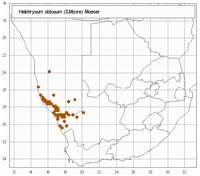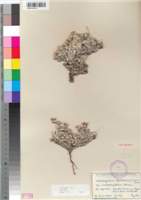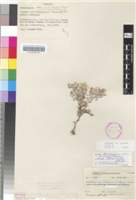Origin of name:
obtusum/ -a/ -us = blunt tipped
Diagnostic characters:
Small grey-woolly leavesSmall heads often solitary and surrounded by leavesStraw-coloured bracts, often tinged pink
Description:
Shrublet, main stem very short, 5-50 x 5-10 mm, bare, woody, gnarled, branches numerous, intricate, spreading, forming a dense cushion up to 150 x 300 mm, often much smaller, white silky-woolly-felted, leafy. Leaves mostly 4-10 x 2-5 mm, oblong-lanceolate to broadly elliptic or suborbicular, narrowed below in broader leaves, half-clasping, apex subacute, recurved, margins undulate, both surfaces densely white-woolly-felted. Heads heterogamous, very rarely homogamous, campanulate, c. 4 x 4 mm, solitary or few clustered at the tips of the branchlets, closely surrounded by leaves. Involucral bracts in 3-4 series, subequal, loosely imbricate, about equaling the flowers, not radiating, obtuse, often emarginate, golden-brown to buff or whitish, often red-purple above stereome, stereome woolly outside, outer bracts and surrounding leaves webbed together with wool. Receptacle nearly smooth. Flowers (12-) 20-42, (0-) 2-9 female, 12-33 homogamous. Achenes not seen, ovaries with myxogenic duplex hairs, or very rarely glabrous. Pappus bristles many, about equaling corolla, scabrid, bases with patent cilia, not cohering.
Flowering noted in all months, but chiefly in September.
Distribution:
Grows in sand or gravel among rocks on the desert hills; four of the six doubtful specimens were recorded on limestone; the other two collectors did not record soil type. Recorded mainly from the southern part of Namibia, from Windhoek southwards to the Orange River, and from Alexander Bay in Namaqualand eastwards to Pofadder, Riemvasmaak and Kakamas.
Desert and Nama Karoo Biomes.
Notes:
Specimens can be much dwarfed with densely tufted branches and small leaves, or laxer with relatively large leaves. Variation, which is probably induced by growing conditions, is continuous and there is no geographical patterning to it; it is not possible to uphold the two varieties described, purportedly distinguishable in characters of leaf size, shape and degree of reflection of the tips.Sometimes confused with H. litorale, but the crisped-undulate leaf margins of H. obtusum are a good distinguishing feature, and so is the uniseriate pappus.
Six records from much further east (Cape, Middelburg, Acocks 19133, PRE; Barkly West division, Boetsap, Brueckner 138, PRE; Griqualand West, Campbell, Wilman 1436, BOL; Griqualand West, Cook 11, BOL; Douglas, Mazelsfontein, Anderson 580 (BOL); O.F.S., Luckhoff, Verdoorn 2162, PRE) are included with slight reservation, but I can detect no real distinguishing feature, though the heads are homogamous, while generally, but not always, heterogamous in the typical plant.
Taxonomy:
Literature:
Helichrysum obtusum (S. Moore) Moeser in Bot. Jb. 44: 297 (1910); Merxm. & Schreiber in Mitt. bot. StSamml. M�nch. 2: 329 (1957); Merxm., F.S.W.A. 139: 96 (1967).
Type:
Namibia, Great Namaqualand, Gubub [Garub?], July 1897, Dinter 1212 (Z, holo.; fragment BM, iso.).
Synonym(s):
H. dinteri var. obtusum S. Moore in Bull. Herbarium Boissier 2, s�r. 4: 1016 (1904).
H. obtusum var. namibense Merxm. & Schreiber in Mitt. bot. StSamml., M�nch. 2: 329 (1957). Type: Namibia, L�deritzbucht, Dinter 6007 (M, holo.; BM; BOL; E; G; K; fragment NU; PRE; S; SAM; Z, iso.).
H. obtusum var. microphyllum Merxm. & Schreiber in Mitt. bot. StSamml. M�nch. 2: 329 (1957). Type: Namibia, Windhoek distr., between Kapps Farm and Windhoek, Walter 134 (M, holo.; PRE; WIND, iso.).
Vouchers:
Acocks 14400 (PRE); Giess 12983 (M; PRE; WIND); Merxm�ller & Giess 28279 (M; PRE; WIND); Pillans 5575 (BOL); Range 495 (SAM).


_sml.jpg)
_sml.jpg)
_sml.jpg)
_sml.jpg)
_sml.jpg)
_sml.jpg)
_sml.jpg)
_sml.jpg)


